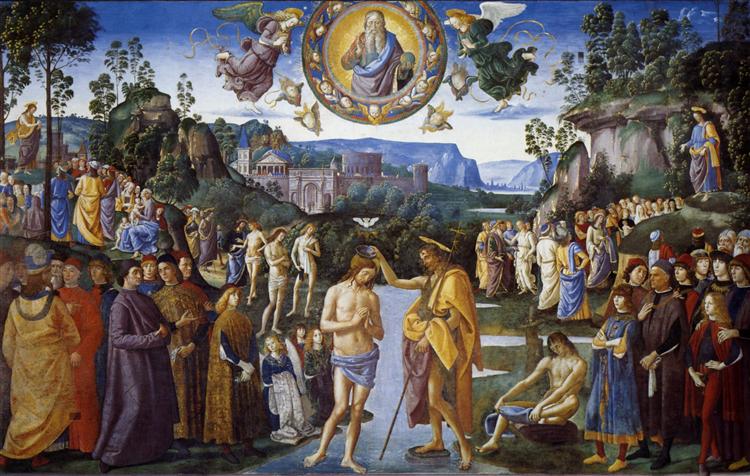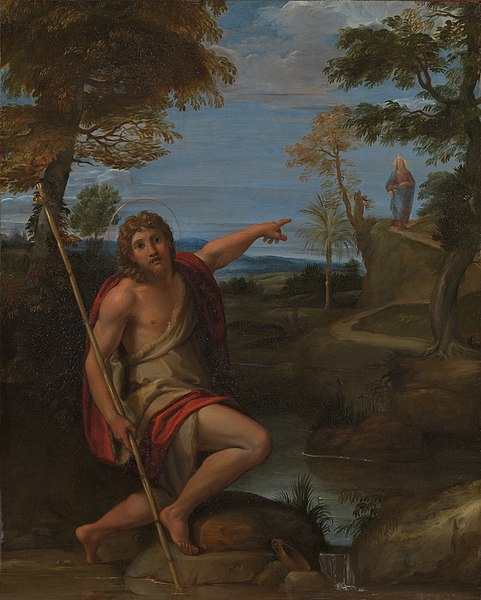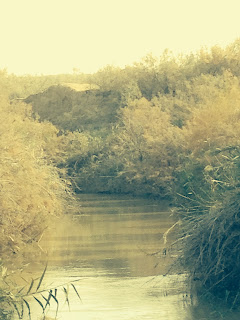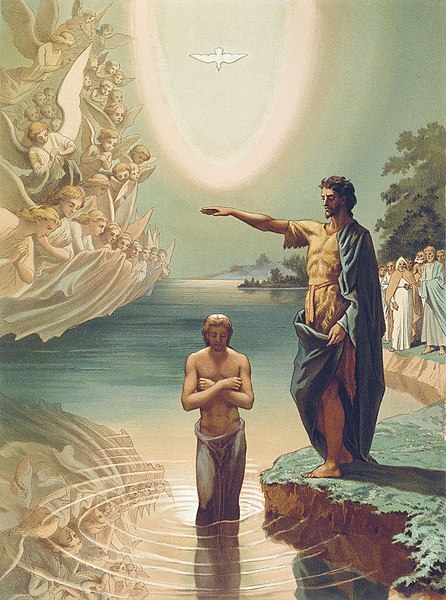 |
| Baptism of Christ, Pietro Perugino 1481-1483 (PD) |
I grew up in a household that savored the film genre of the all American western.
Especially, those films that starred “The Duke”, John Wayne.
My father loved John Wayne so much, that a congregation he served gave him a bust of John Wayne that was proudly displayed in our home for many years.
Being the rebellious soul that I am, I grew to appreciate westerns and even John Wayne, but I came to find that I needed a little bit of twist to that genre of film.
While still falling under the umbrella of western, I grew enamored with the Italian genre of westerns that has come to be known as “The Spaghetti Western”.
You may be familiar with this cinematic storytelling line through much of Clint Eastwood’s earlier work; The “Dollars Trilogy”
This trilogy included the films “A Fistful of Dollars,” “For a Few Dollars More,” and of course my favorite western of all time “The Good, the Bad and the Ugly”.
It wasn’t so much the historical time being portrayed that intrigued me, as much as the storytelling technique.
A technique that director Quentin Tarantino has argued can be applied to a movie shot in any time period, even making a film that he declared to be a World War II Spaghetti Western at one point.
The director of the “Dollars Trilogy,” Sergio Leone, is usually credited with establishing this style of cinematic storytelling.
And he introduced a few common elements in the manner he told the stories.
Firstly, there had to be an unresolved conflict that was already taking place prior to the introduction of the main characters, usually a conflict that they themselves had no part in, but just found themselves in the middle of.
Secondly, this style of storytelling used irony and tragedy in a Shakespearean comedic sense.
Thirdly, characters found themselves making uneasy alliances.
Partnerships with competing characters who were not necessarily evil -although sometimes they were- but characters that were needed to complete the task at hand.
Finally, my favorite part of the spaghetti western was the introduction of the lead protagonist;
Now, for those of you who just envisioned that opening sequence with a sense of nostalgia, I want you to apply those elements, maybe even the soundtrack, to today’s Gospel.
“His winnowing fork is in his hand, and he will clear his threshing floor and will gather his wheat into the granary; but the chaff he will burn with unquenchable fire.”
“And just then, Jesus came from Galilee to John’s territory in the Jordan, to be baptized by him”.
Today’s Gospel proves to us that Sergio Leone may actually not be the originator of the Spaghetti Western at all.
 |
| Saint John the Baptist bearing witness, Annabale Carracci, circa 1600 (PD) |
It may have been Matthew.
You see?
Each of our gospel accounts introduce Jesus in specific ways.
Mark just throws us into the deep end of the gospel, quickly introducing us to John and then beginning with the baptism of Jesus.
No character development what-so-ever. Just presenting the story in the most brutal straightforward fashion imaginable.
This is one of the things I most appreciate about Mark.
Luke, on the other hand, spends a great deal of time developing characters.
Luke is the only gospel that takes the time to account for Jesus’ childhood at all -as Pastor Stephen mentioned last week.
Luke’s gospel is storytelling in a traditional sense.
Matthew though, Matthew presents us with the spaghetti gospel.
Matthew gives us glimpses of Jesus’ background;
the genealogy,
how things occurred,
why they occurred,
outside influences,
But NO introduction to the character.
And John’s announcement as the introductory scene is about to be shot is intimidating, if not downright terrifying
Almost like the introduction by ring announcer Michael Buffer before a fight;
“Let’s get ready to RUMBLE!!”
And as Jesus steps onto set, I can almost see the tumbleweed blow across his path.
Jesus, the man from Galilee steps into Matthew’s gospel as a mysterious figure.
Of course, we don’t see it this way because we know the story but for Matthew’s audience, he has been building up to this.
In fact, so has John.
John doesn’t fully know what to expect but it is fairly obvious that John is in awe of Jesus.
John doesn’t even get a chance to object to Jesus’ request for John to baptize him. Jesus cuts him off at the pass, declaring John’s role in this mission, assuming John is prepared to take up this uneasy alliance with Jesus.
An alliance that is uneasy, not because Jesus doesn’t trust John, but because John knows he is unworthy to share the task Jesus has come to fulfill.
This is the most extensive dialogue between the two in any of the gospel accounts, and this is pretty clear in Matthew, when John adamantly declares his unworthiness.
John knows he is not “the Good.” He can’t be. He is a human being and therefore flawed.
But John is also not “the Bad,” because he is actively participating in the fulfillment of Jesus’ task, just trying to keep a lid on the rowdy town until Jesus arrives on scene.
John is just “the Ugly,” because he cannot hide his flawed human nature nor does he try.
It is why he quite honestly demands that we all repent, because he faces his flawed human nature for what it is, yet this is the very reason Jesus chooses him.
But there is another uneasy alliance that is made.
It is an alliance between God and humanity.
Because baptism for us serves as a means by which we may identify with God, through Jesus.
But the most powerful part of this alliance is that the Baptism of our Lord becomes the means by which God identifies with humanity, through Jesus.
Miles up the road, Jesus could have been baptized in the mikveh baths at Qumran, where a monastic order of Jews took part in these spiritual baths multiple times a day before engaging in study of the scriptures.
Some scholars even believe it may have been the community John came from.
But this is not the place Jesus decides to be baptized.
A few more miles up the road, lay Herod’s palace fort, Masada, which was home to Roman engineered heated baths.
If it was good enough for Herod, don’t you think it would have been good enough for God?
But instead, Jesus intentionally seeks out John to be baptized in the same muddy creek as all John’s desperate followers.
The Jordan river, which in spite of all the movies and storybooks, is just that; a muddy creek in the middle of the desert
 |
| Jordan River on the border between Israel and Jordan in 2014 |
Full of silt
Full of mud
Full of our own sin.
There are many reasons that could be cited for Jesus’ baptism at this spot.
But when I read this story and when I knelt beside those waters, I could draw no other conclusion except that God sought out the most lowly place to claim solidarity with us, baptized in the same dirty water, polluted with our own sin.
Taking on that uneasy alliance with them, with you, with us, with me.
Entering into a conflict that God did not cause, a life of suffering that was never part of the blueprint for creation,
Putting on a tin badge in a town -a world- that hasn’t known righteousness in so long, no one even knows what it would look like.
And there you have it, the spaghetti gospel according to Matthew.
It’s got all the elements: the introduction of our main character; the mysterious protagonist; an uneasy alliance with a less than trustworthy humanity; the ironic, tragic, and lowly placement of our hero in an entirely unworthy and hostile location.
And finally, a hopeless conflict that is not only impossible to solve but shouldn’t even fall on the shoulders of this dark stranger, who had no part in contributing to this mess in the first place.
But there is a flaw in the formula that stands out in the gospel for today.
And it points out something that we can all relate to.
The flaw is in this alliance.
John nearly objects to the alliance on grounds of unworthiness, which is a valid concern.
But John also objects on grounds that we also object to, daily.
John objects on grounds of lethargy.
John, his followers, you, me, us, all of us;
We call out for a savior in our time of need.
And when that Savior shows up, we lie down and wait for our Savior to do all the heavy lifting for us.
In our baptisms, we are supposed to take on Christ the way God took on humanity through Jesus.
So baptism serves as a bridge between us and God, but it seems like we are too busy calling for God to cross that bridge than to see the opportunity that the bridge gives to us.
Not a bridge into salvation, but a bridge that allows us to be in relationship with God.
Last week, Pastor Stephen mentioned the heart wrenching irony in the story of Herod’s slaughter of the innocents.
And he mentioned that in spite of the birth of Jesus, even with the reality that is God entering into the world with us, God does not force us to participate in the righteousness of God, and this is why that tragedy and so many others continue to occur.
But although God does not force us to participate in this righteousness, through our baptisms God INVITES us to participate.
When John claims to be unworthy, it isn’t just that John sees himself as unworthy, John sees himself as UNABLE.
John is overjoyed that there is a new sheriff in town but just as John believes himself to be free of the burden, he finds himself being deputized into this mission with Jesus when Jesus proclaims,
“Lay down your piety, your inability, your unworthiness, because WE will fulfill all that is meant to be made righteous.”
“WE will fulfill.”
Doesn’t sound like John gets to turn in that tin star just yet, does it?
We cry out and cry out, over and over again to God and we always seem to proclaim that God is not listening.
And while the squeaky wheel may get the oil, all the oil in the world isn’t going to help a flat tire.
Jesus doesn’t ride into town to take away our responsibility or our accountability, Jesus rides into town to take on our sin and offer God’s grace.
That is the gift that erases the consequences, but it doesn’t erase the mess we’ve left.
~
This past New Year’s Eve, my wife and I were planning out our holiday evening.
She was trying to stay awake on the couch while I was daring myself into taking a Zantac and a NyQuil gel tab at the same time.
New Year's Eve programming has become distasteful and a bit confusing to us, the older we get.
So, my most daring move was turning the channel to one of the New Year's Eve programs,
But I caught it just in time to see a commercial that seemed to sum up everything I had heard from so many about this past year.
I didn’t even know it was a commercial for Google, all I knew was that the first 20 seconds of the video that was ushering in the New Year made me feel like EVERYONE claimed they were feeling about 2016; HOPELESS.
But the final 1 minute and 40 seconds of that commercial reminded me of how many wonderful things have happened this year.
As Stephen Colbert proclaimed, “Love does not despair, Love gives us hope that change is possible” and then the 12 year old breakout musician Grace Vanderwaal sang
“You and me, we stand out of the crowd
Cause we are not afraid to let our light out
So trust in me and just have no doubt”
It gave me goosebumps and it has every time I’ve watched it since, with one exception, the ending.
Because at the end the screen went blank white and read,
“Love is out there, Search on”.
As if our faith is grounded in a search engine!
I don’t care what you take away from this sermon today, if you’ve slept through the whole thing, so be it.
But if you hear one thing today please hear this;
But if you hear one thing today please hear this;
When Jesus rides into town, the search is over.
When we are washed in the waters of our baptisms that search ends.
Because that is when we are called by name, just like John, to stop despairing in the unrighteousness of the world around us and instead live into the task Jesus leads us into.
Amen
 |
| Baptism of Christ, Grigory Gaagarin 1840-1850 (PD) Sources
Brian
Sierzega. “Let’s Get Ready to Rumble!!:: Michael Buffer.” YouTube.
August 27, 2014. Posted January 3, 2017.
https://www.youtube.com/watch?v=jgopHWACUXs.
Google.
“Google - Year in Search 2016.” YouTube. December 14, 2016. Posted
January 3, 2017. https://www.youtube.com/watch?v=KIViy7L_lo8.
Leone,
Sergio and Luciano Vincenzoni. The Good, the Bad and the Ugly. Directed
by Sergio Leone. Beverly Hills, California: United Artists, 1966. Film.
Schmader,
David. “Inglourious Basterds: Tarantino’s Spaghetti-Western War Flick.” 1535.
Accessed January 3, 2017.
http://www.thestranger.com/seattle/inglourious-basterds-tarantinos-spaghetti-western-war-flick/Content?oid=2069921.
|
No comments:
Post a Comment